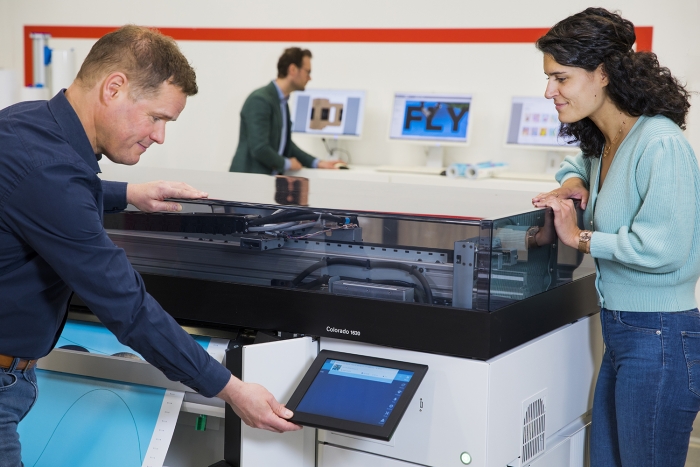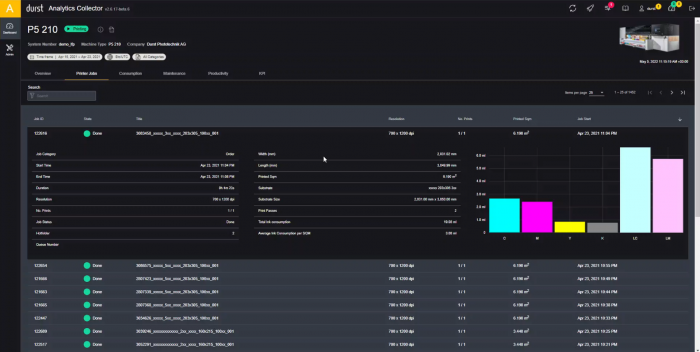In conjunction with the newly published Image Reports Widthwise survey 2022 we asked a number of manufacturers how the findings reflect what they’re seeing within their own companies and in the wider market - and how they are tackling key issues flagged up by the poll.
If you get your hands/eyes on a copy of the Image Reports Widthwise Report 2022 (just out and available to download for free at www.imagereportsmag.co.uk/widthwise) you’ll get a full analysis of the data supplied from the 201 UK/Ireland companies that took part in the poll earlier this year. That data showed that more than a third of those large-format print providers who took part have no technical issues with their wide-format kit, which is great, but it means the other two thirds obviously do have issues - 22.39% flagged up ink and media reliability issues, 15.42% machine reliability, 14.93% workflow/system integration issues, and 11.44% colour management concerns.
From a technology development and adoption perspective, it’s also worth noting that when asked if they intend to invest in the Internet of Things (eg. automation, AI, remote diagnostics) in the year ahead, almost three-quarters (74.63%) said ‘no’. Only 5.97% said a decided ‘yes’.
We gave a number of the sector’s manufacturers/suppliers these findings and asked for their responses. Here’s what they had to say…
Agfa
Paul Fitch, sales manager UK/Ireland, Agfa UK
The findings are in-line with what we hear when talking to professionals in the wide-format market. Agfa’s strengths is to offer solutions. Colour management is in our DNA as we have more than 150 years of experience in the graphic industry. Our R&D teams stay up-to-date to the worries and concerns, but also to the needs in the field. In close coordination, we can thus offer help quickly.
Antalis
Paul Duffy, visual communication business development manager
In my experience, issues with machinery, media and ink compatibility tend to be more prevalent just after the installation of a new machine, or with a new user unfamiliar with the technology, media and applications - things that often can be overcome by comprehensive training.
Antalis’ technical experts are on hand to help users of all experience levels and to provide support in diagnosing issues and finding solutions. We first look at the media selection to ensure compatibility with the printer, or the intended application if the reported issue has arisen after fitting. If it is print-related, we look at the printer, ink type and Rip settings including colour management, offering advice on how to make necessary adjustment. We also assess environmental factors, such as whether the media is acclimatised to the working temperatures in production.
If the reported issue has developed after fitting, we assess the way the product has been finished and installed as many variables contribute to application issues once the job is in situ.
Antalis media is tried, tested and distributed internationally. Fortunately, manufacturing media faults are rare, but issues can arise, and our suppliers are on hand to assist.

Canon’s Prisma XL Suite simplifies and automates production for both flatbed and roll-to-roll machines.
Canon
Mathew Faulkner, EMEA director, marketing and innovation, wide format printing group, Canon Europe
The results of the Widthwise Report 2022 are not surprising and in fact reflect the conversations we’ve had with PSPs. Following on from the heavy impact of the Covid-19 pandemic, PSPs need solutions that enable them to achieve maximum uptime and meet changing customer demands for faster turnarounds and an increasing number of personalised applications. As a result, many are looking for more productive systems that offer a broader application range. This was one of the main reasons Canon developed UVgel technology and, based on that technology, we designed the Colorado and end-to-end print solutions, such as our wallpaper factory.
Print/graphics producers are also looking to reduce the total cost of ownership of their systems and avoiding the technical issues flagged up in the survey plays a big part in this. To help them achieve profitable growth we are continually investing in R&D for both hardware and software, as well as working with partners.
We’re always adapting our products to meet the changing needs of our users. Recent innovations have included increasing the ‘stretchability’ of UVgel inks by 15% to 85% so that customers can print a wider range of applications; and the introduction of FLXfinish+, which provides the ability to print on the Colorado mixed matte and gloss finishes on one print without a varnish, just using the curing properties of UVgel.
We’ve found that generic ‘IoT’ or ‘workflow software’ is not perceived by most customers as adding significant value - what they want is tangible automation that is simple to implement, delivers clear benefits and has justifiable costs, and we’ve seen strong interest from customers looking to invest in such automation. In response, Canon has designed specialist wide format-focused applications such as our recently launched Prisma XL Suite, which has powerful tools to simplify and automate production for both flatbed and roll-to-roll technologies. The software helps customers to create amazing high-value applications in simple steps, with a common interface and with remote tools for unattended operation.
Durst
Peter Bray, managing director, Durst UK/Ireland
I can see a correlation between the findings and what we have seen both for ourselves and from feedback within industry in general. In the last year, industry has had to face a series of global challenges and anything that impacts upon manufacturing lead times does contribute towards intense pressure points at times within business, ours included.
We have grown our technical departments, both from our headquarters and in the UK/Ireland, as well as enhanced our service desk to provide continuity with ongoing relationships. In addition to our Durst Customer Experience Center in our headquarters in Brixen, Italy, we now also have a new state-of-the-art training facility there.
Our Durst Analytics - clever software with an important role in collecting information for predictive maintenance and now a standard part of all new machine installs - is helping us going forwards.
We have also been developing a technical infrastructure with machine-learning technologies that enables predictive maintenance measures in production environments and that will soon become a reality.
The analysis is based on a framework for AI (Artificial Intelligence) or machine learning prediction analysis. By constantly tracking and analysing sensor data and parameters, we will be able to determine whether a part will fail before it fails. This gives us the time to proactively organise with our customers a service intervention according to their production planning. This is part of our wider aim to have no unplanned service requirements by 2025.

Durst analytics collects information for predictive maintenance and is now standard on all new machine installs
Epson
Tom Owers, product manager, commercial imaging, Epson UK
Epson has developed its own ink technology and printhead technology that have been designed to work in harmony to deliver optimum performance.
Having the ability to create consistently sized output is crucial - a common issue is the misalignment between neighbouring panels from tiled output, for example indoor décor. Epson has developed a media handling system for its S Series range that has also been deployed on the SureColor SC-R5000 series resin ink large-format printer. The system monitors the media feed and applies back tension to compensate for the change in roll weight. It ensures the feed remains constant from the start of the roll to the end of the roll.
The SureColor SC-R5000 series also uses a three-stage curing process that allows more accurate control of the temperature on the media for enhanced colour consistency. The curing process starts as the ink hits the substrate, which means a lower overall temperature can be used. As a result, the material is not over stressed avoiding deformation to the backing sheet or elongation of heat sensitive substrates.
In terms of machine reliability Epson’s systems are developed specifically for applications (eg. the SureColor SC-F2100 is a genuine DTG printer rather than a re-purposed consumer grade Epson photo printer). They incorporate micro piezo printheads that generate little to no heat, so the nozzles don’t degrade, ensuring stability and accuracy during the lifetime of printer. They also are equipped with built-in auto maintenance (auto head wiper, ink circulation etc.) that minimises user intervention and maximises printer uptime. The SureColour R5000 also features user replaceable printheads limiting printer downtime should an issue arise.
From a workflow/system integration perspective, Epson’s systems include Edge Print Rip software and Epson Total Solution Cloud Port platform for cloud-based services.
When it comes to colour management Epson’s printheads deliver stable and accurate colour. For signage and dye sublimation there is a cloud-based library of EMX files that can easily be downloaded and contain the ICC profiles and mecca parameters for a wide range of third-party media.
HP
Jane Rixon, large format production business development manager, HP UK/Ireland
HP is always striving to mitigate technical issues for customers and has many solutions designed to make the printing process as seamless as possible, with software designed to offer simple fixes to common printing issues.
Software like HP PrintOS simplifies the production processes, offering remote diagnostics, granting greater workflow integration and opening up new opportunities for growth.
As part of HP’s PrintOS platform, users have access to a media solutions locator which provides profiles for various approved and certified materials. PSPs can deploy these profiles to all the machines in their fleet and ensure accurate colour management across multiple devices.
Users can also access PrintOS to give them information on the jobs being printed, ink and media usage etc from their mobile, tablet or desktop computer, and with the PrintOS Mobile app, they can immediately identify printing issues and get control over fleet production virtually anytime.
Learn @HP is also part of this suite of software which brings together a whole raft of online training for operators on how to get more out from the machine, colour management skills etc.

HP Print OS simplifies the production processes, offering remote diagnostics and allowing greater workflow integration
swissQprint UK
Carmen Eicher, chief sales and marketing officer
As to your findings on ink issues, swissQprint set up an in-house ink laboratory some years ago, providing research and development as well as systematic quality control and application tests. By doing so, we contribute towards trouble-free operation in the field. Generally, we develop our inks with a focus on versatility, qualified by actual tests with specific applications.
After that, we systematically test every ink batch before it is delivered from our ink suppliers to customers. Tests include curing behaviour, viscosity, surface tension, colour values, particle size and stability. If a batch is out of specifications, it will not be delivered to prevent problems in the field so customers can rely on consistent quality.
Reliability is a key criterion when evaluating a printer. Productivity is, too. However, what use are high print speeds if the machine keeps being down due to technical issues, not to mention the loss of material and time? At swissQprint, reliability is part of the mission - as we see it, the foundation is solid machine engineering. Also, we attach great importance to designing our machines for a long service life, and we use high-quality parts. We believe that it is crucial to have full control over the components and production of the machines. That is why we develop everything in-house at the Swiss headquarters, starting with mechanical components over to boards and firmware to the output software. The interplay of the different elements is thoroughly tested before anything is released. In production, the machines are put through several stress tests again.
Last but not least, the machine design is optimised for easy field support. For example, if need be, the printbed can easily be re-levelled at a customer’s site. Generally speaking, it is essential that the machines are well maintained to guarantee smooth operation. While the operator performs small tasks on a regular basis, swissQprint recommends annual maintenance done by a qualified technician to check all moving parts, adjust the machine, and possibly detect issues at an early stage.


